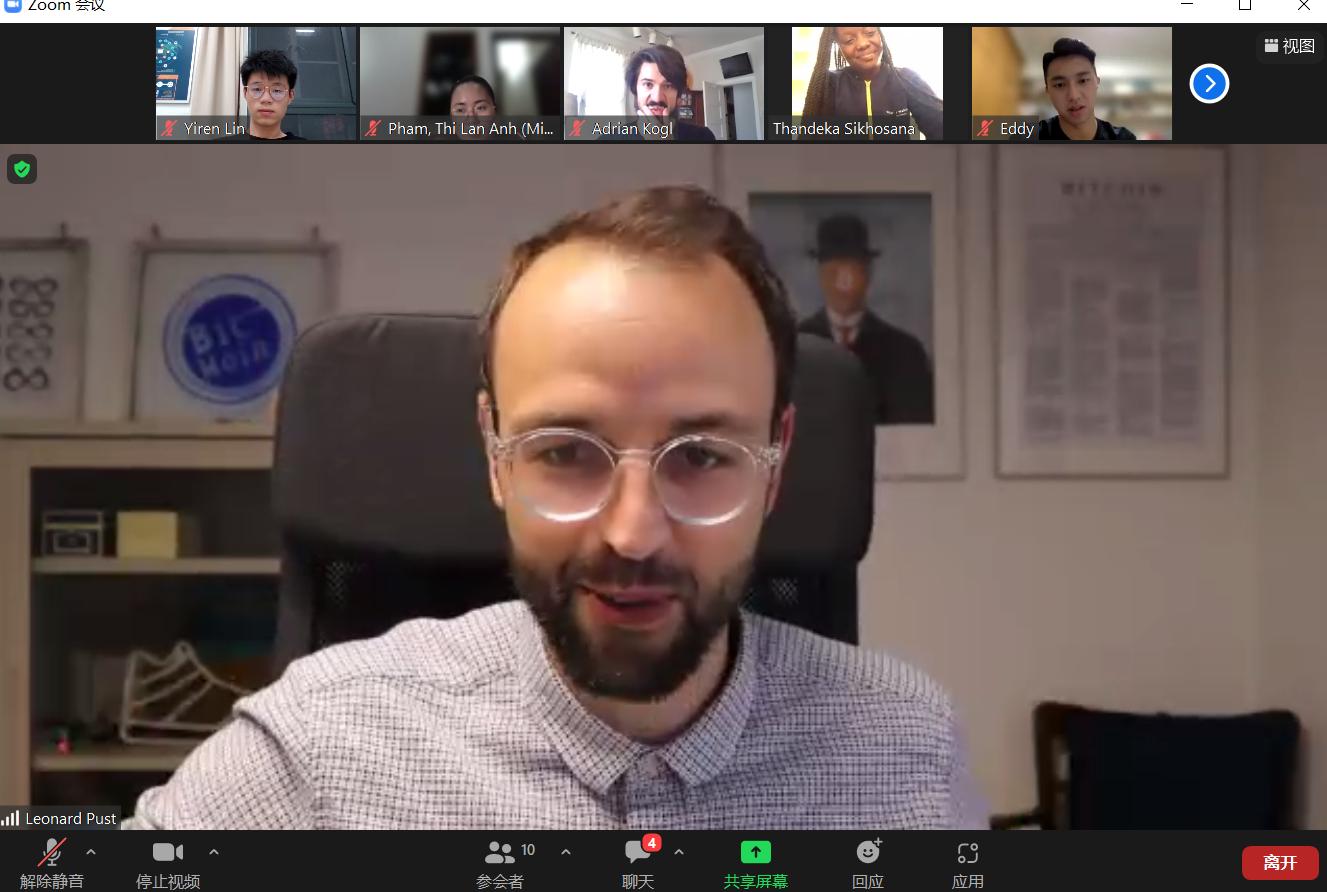Digital Currencies and Blockchain Technology Course 1
The image showed above may contain the only piece of Chinese in this article, haha😁

What the image shows is the greeting part, it’s the first time that I attend a class with listening and speaking English throughout the whole class. The teacher, Leonard is friendly and enthusiastic in teaching. My fellow students also participated a lot in this class. The speed of English speaking by the teacher was acceptable, and I can basically understand what he said.
In the greeting part all of us students opened the video and microphone to greet with each other by doing brief self-introductions and telling others what “hello” says in our native languages. For me, I told others that I come from Shanghai, PRC, and is majoring in Data Science and Technology, in East China Normal University. By saying “having no pre-knowledge of digital currenciesm and is not so good at English due to the little exposure to English in daily life”, I expressed my hope to both learn concepts of digital currencies, bitcoin, blockchain, and expose me to an environment full of English to help me practice my English listening and speaking skills. And then I told others how “hello” is expressed in our language, both in Mandarin and Shanghainese, and felt proud to broadcast Shanghai culture. Eddy, the guy from Taiwan, also spoke “nihao” in mandarin, yeah because Taiwan also successes Sun Yat sen’s idea(then it’s a history story yeah, and I don’t want to say it here, but I vote for Taiwan).
And my classmates did their introductions as above one by one, most of them had their videos turned on, creating an atmosphere of face-to-face chatting.
Leonard, the lecturer, is 35 years old, and the biggest head in the image above is him😄. He told us to engage ourselves in the class and he’ll explain everything as easy as possible, especially for students like me who had no knowledge of this area before. Without the engagement in the class and just let him talk online is not different with watching a video on youtube.
He also talked about the test form of the course, a presentation will be done on July 14, the last class, and no test and exam. All of the students will be divided into 3-4 groups and do the presentation in the unit of groups. After the full participation in the class, a grade certificate will be handed to us.
List of participants(in no particular order)
- Thandeka Sikhosana
- Yuhe Zhang
- Eddy
- Theopatria Goliath
- Yuven Ganeshan
- Adrian Kogl
- Pham
- HUAWEI Y7p
- Saugat
- Mia
- Yiren Lin
Main content of the course
For currencies, most people just know when to buy, when to sell. But only a few people understand bitcoin and can use it to satisfy their needs.
Some basic info of bitcoin:
- Abbr.: BTC
- Open Source Software
- High Security
- What Company Behind: Not controlled by any central institution
- How many exists? Limited number: 21 million. So bitcoin is also regarded as digital gold.
- Divisible: the smallest unit of bitcoin is satoshi, equals 10^-8^ bitcoin
- Decentralized
- Based on Math, particularly on cryptography
- Running the bitcoin P2P protocol
- Payments with bitcoin can’t be reversed
- Cannot be issued multiple times (“double-spended”) (attacks the network and reacquire a cryptocurrency)
Five pillars of bitcoin:
- Open - Anyone can access to it, even not a human. When you use it, bitcoin doesn’t know who you are.
- Borderless - International currency, no physical form, think of the mind.
- Neutral - It’s my money, but not the fucking business. Shouldn’t care about the communication and purpose, and nobody knows about this.
- Censorship-resistant - If somebody want to stop the money transaction, they can’t. Money is communication, and human have their rights to ask for them, and use them. Money, as other forms of communications, is part of human rights.
- Public - Everything I do is verifiable, and transparent.
Where do we store bitcoin?
Bitcoins are stored in a wallet, a digital wallet. Every wallet contains a set of private keys without which the bitcoin owner cannot access the currency. The biggest danger in bitcoin security is the individual user perhaps losing the private key or having the private key stolen.
The public key is the bitcoin address account number.
What is blockchain?
Decentralized, transparent, public record of all transactions.
The blockchain is like a notebook, and the block is like a page in the notebook, and a transaction is like a line in a page.
Every 10 minutes, the lines on all blocks in the bitcoin blockchain update like a heartbeat.
What is bitcoin mining? Why do they mining?
For creating bitcoins.
Proof-of-work, describes a system that requires a not-insignificant but feasible amount of effort in order to deter frivolous or malicious uses of computing power, such as sending spam emails or launching denial of service attacks. The concept was subsequently adapted to securing digital money.
It is a decentrallized consensus mechanism that requires members of a network to expend effort solving an arbitrary mathematical puzzle to prevent anybody from gaming the system.
And the process comes as follows:
- New transactions are sent to all miners.
- Miners collect transactions in a block.
- Miners try to solve a math problem for their block/ competition.
- Miner, who solves the puzzles first, shares the result with the whole network.
- Network confirms the right solution.
- Block’s added to the blockchain.
- Miner receives(6.25) bitcoins and transaction fees as a reward.
Auto-adjusting algorithm: if a problem is too hard to solve, and the average solving time is longer than 10 min, the next coming problems will be easier to make it shorter than 10 min to solve, keeping the heartbeat time at 10 min consistently.
Every 210,000 blocks, the reward halves, and the difficulty is adjusted every 2016 blocks.